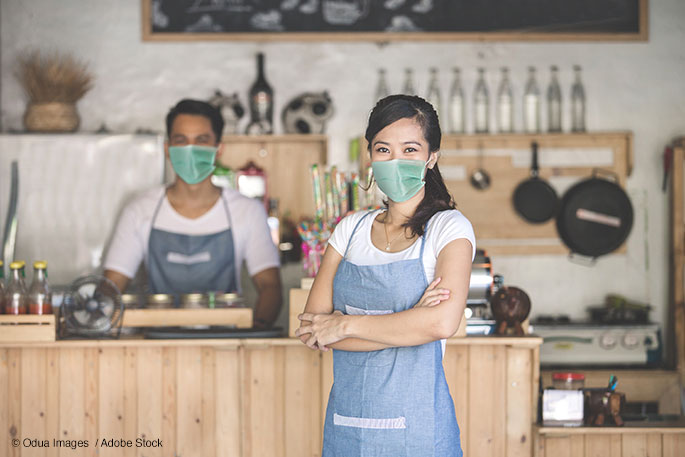
The safety of customers and employees has always been important in the restaurant industry. This was true before the pandemic and remains true today. In a post-COVID world, there is now an even sharper focus on sanitation and cleaning protocols for restaurants.
Since COVID-19 can be spread from person to person through close contact, effective sanitizing reduces the risks in the food services industry and beyond. As economies start to reopen and businesses adapt to the new normal, restaurant owners must comply with the government requirements. Extra precautions, such as the increased use of waste disposal and recycling bins, are needed to improve safety and reduce infection risk.
In addition to physical distancing and personal hygiene, proper sanitation best practices are strongly recommended. A clean restaurant environment keeps your staff and customers safe after reopening dining rooms or patios. To ensure your business is following the right COVID-19 protocols, follow this guide about restaurant sanitation:
Improve restaurant cleaning procedures
Your restaurant cleaning procedures and protocols must be revisited in a post-COVID world. Special attention is needed for high-touch objects and surfaces in restaurants. The entire restaurant should be cleaned thoroughly upon reopening, and janitorial schedules should reflect the increased cleaning of high-touch areas. These include the back of the house, restrooms, front-of-house counters, and door handles.
Shared equipment like POS stations, headsets, and credit card machines should be cleaned after every use. When cleaning tables between every seating, post-COVID sanitation should be spent on sanitizing high-touch objects, such as sauce dispensers, salt and pepper shakers, and cutlery. Reusable menus should be sanitized, and paper menus should be disposed into recycle containers after each use.
Personal protective equipment for chefs & staff
In many restaurants, the working conditions are often within a closed and confined environment. Since staff members frequently exchange contact with each other, this makes physical distancing quite challenging to maintain sometimes. As such, restaurant owners should invest in personal protective equipment for chefs, staff members, and customers.
Make sure everybody working in your restaurant will have access to the personal protection equipment (PPE), including face shields or face coverings. Gloves should be made available to food workers and cleaners.
Each employee should understand how to effectively use the PPE for cooking and handling food, in order to stay safe and keep others safe.
Personal protective equipment also requires proper disposal to reduce the spread of germs and infection. Make sure that PPE disposal bins are available and secure in your restaurant. These bins are clearly labelled for the disposal of masks and gloves. They make an excellent addition to a restaurant’s waste and recycling program after the pandemic.
Disinfectants for restaurant tables & equipment
Cleaning products alone cannot sufficiently reduce the risk of COVID-19 infection. While cleaning products can remove dirt and contamination, and reduce the number of germs on surfaces, they do not kill germs entirely. Even if the surfaces may look clean, there could still be germs on tables or countertops that aren’t visible to the naked eye.
For extra precaution, restaurants should use disinfectants to sanitize the surfaces. After cleaning thoroughly, an approved sanitizer with an eight-digit drug identification number (DIN) should be used on hard surfaces to kill the germs. This DIN confirms that the government approves the disinfectant for use. It’s essential for food and customers’ safety to avoid food contact surfaces when using these disinfectants.
Alternatively, a bleach solution can be used to inactivate or destroy the virus. When disinfectant cleaning products are not available, use a 5 ml bleach and 250 ml mixture to clean hard surfaces. The solution should be in contact with the surface for a minimum of 1 minute to be effective. Only use bleach in open areas, while ensuring the solution isn’t expired and hasn’t been opened for more than 6 months.
For high-touch electronic devices, such as keyboards, PIN pads, and touch screens, liquid-based disinfectants won’t be as effective. Instead, you should clean these surfaces with disinfectant wipes.
Hand hygiene for restaurants
Hand sanitizers should be available for all staff members and guests of the restaurants. Make these supplies available at the service counter, the entrance, the exit, and any other customer touch point. Also, remind your staff and customers to avoid touching ready-to-eat foods with bare hands.
Also, it is imperative that everyone can wash their hands to reduce the spread of infection. Ensure there is running water, hand soap, and paper towels, as well as a plastic-lined wastebasket in the restaurant restrooms. Ensure your staff will wash their hands thoroughly before entering the workspace and after contact with high-touch objects. Handwashing protocols should be in place before breaks and at shift changes.
COVID-19 underlined the importance of health, safety, and hygiene in the restaurant industry. Following these restaurant sanitation best practices can help to keep your staff and customers safe. Since COVID-19 is a rapidly changing situation, managers should also monitor any changes to sanitizing requirements regularly. With everyone taking responsibility, restaurants can minimize the impact and spread of COVID-19.




































































































































 Three Ways to Engage Teams and Clients to Maximize Your Recycling Program Engagement
Three Ways to Engage Teams and Clients to Maximize Your Recycling Program Engagement  How to Integrate Accessibility Into Your Sustainability Planning
How to Integrate Accessibility Into Your Sustainability Planning  Why Park Benches Can Promote Workplace Well-Being
Why Park Benches Can Promote Workplace Well-Being 
